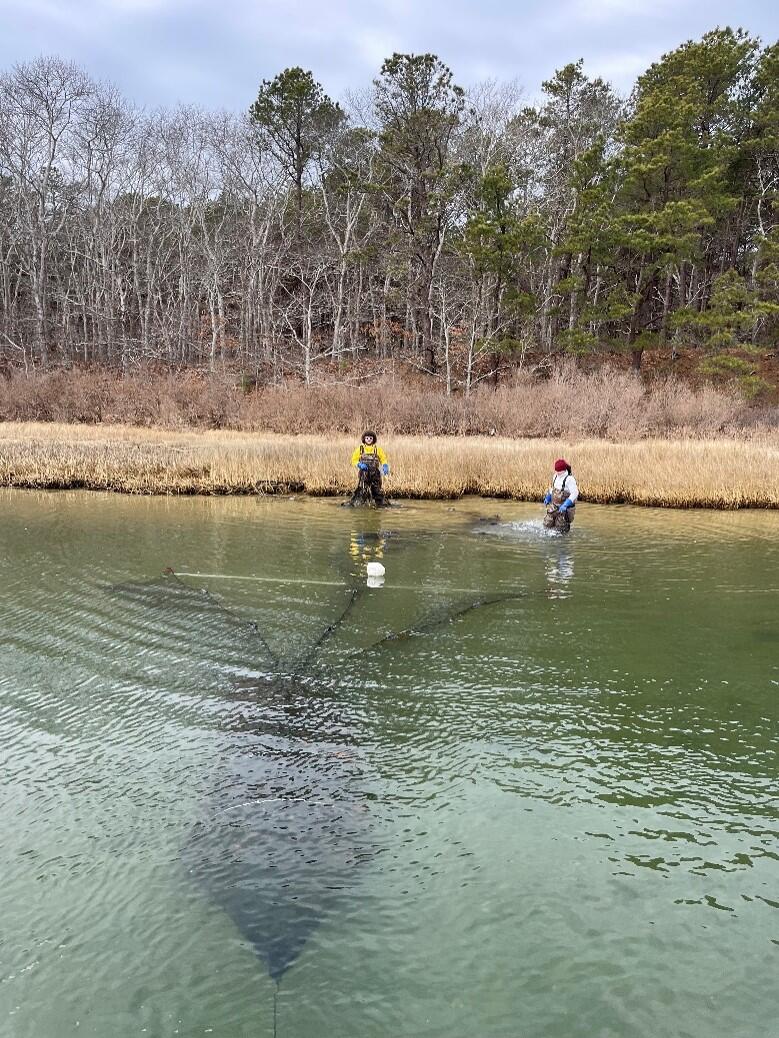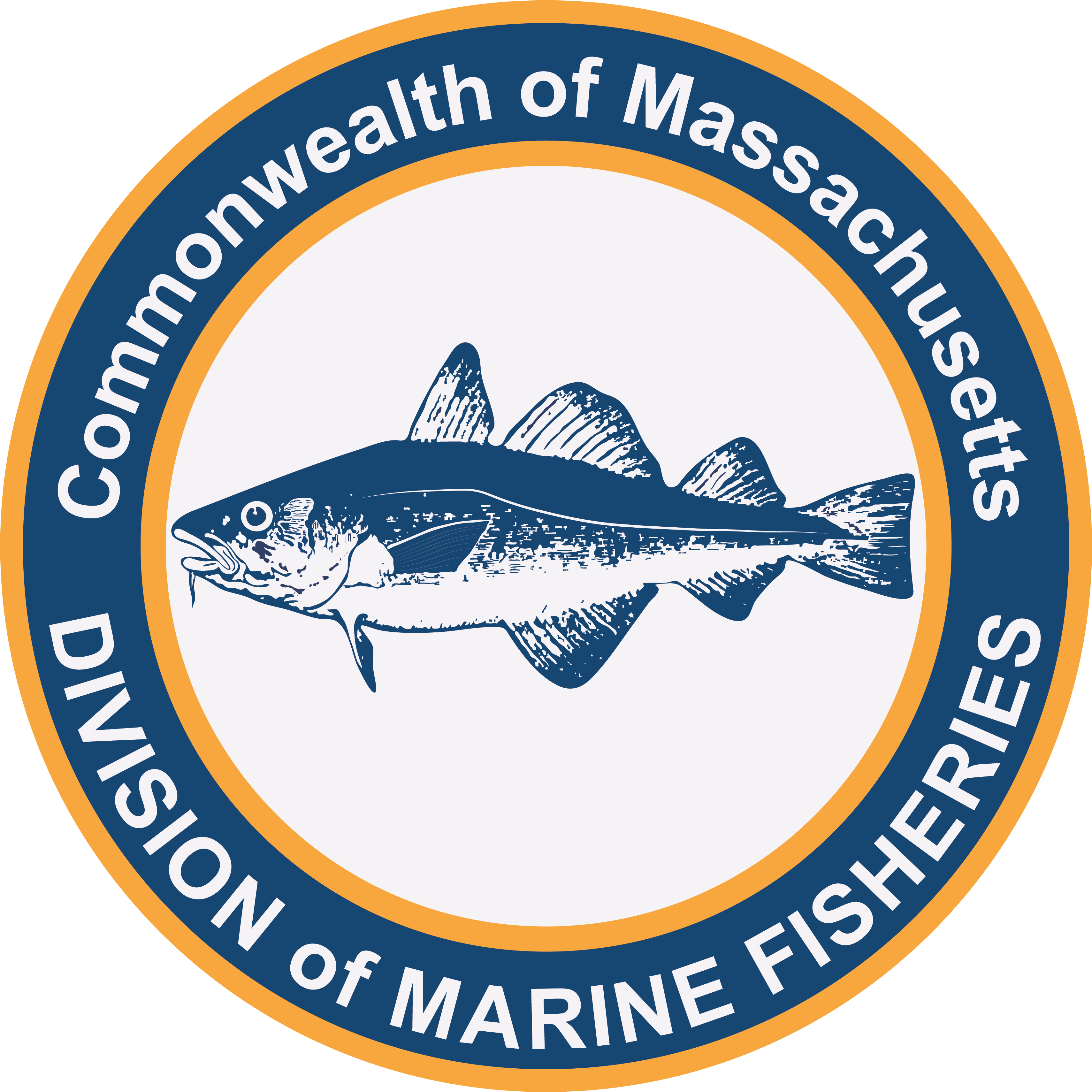- Division of Marine Fisheries

Since 2019, DMF has been devoting available resources to reexamine life history characteristics and habitat use of winter flounder in state coastal waters. Winter flounder are a fairly ubiquitous species in Massachusetts coastal waters, but detailed information on juvenile and adult distribution, spawning behavior, and habitat use is lacking. The potential value of this information, such as for evaluating existing time-of-year restrictions on activities ranging from fishing to harbor dredging, continues to be recognized. DMF has benefitted from partnering with external organizations to expand our research capability, and most recently, state lawmakers directed funding to this cause.
As reported in a 2021 DMF News article (https://www.mass.gov/news/winter-flounder-spawning-habitat-study), this winter flounder research initiative began in 2019 as a “proof of concept” study into the effectiveness of using eDNA to reliably determine presence or absence of winter flounder in coastal waters. (eDNA, or environmental DNA is genetic material from an organism that enters the aquatic environment—such as metabolic waste, shed cells, and mucus—and can be used to identify a species of interest without physically sampling it.) DMF first collaborated with Rhode Island Division of Marine Fisheries to collect water samples during their winter flounder fyke net survey, in addition to during our state winter flounder seine survey, and partnered with the Gloucester Marine Genomics Institute (GMGI) to develop primers for detecting winter flounder eDNA in the samples, and validate these against the survey collections. With promising results in hand, DMF expanded its water sample collection in 2021–2022 with monthly sampling in six Cape Cod embayments: Sesuit Harbor, Wellfleet Harbor, and Pamet Harbor on the north side and Green Pond, Waquoit Bay, and the Bass River on the south side.
With the dedicated funding in the FY23 budget, DMF selected one of these embayments, Waquoit Bay, to conduct a fyke net survey paired with continued water sampling to further validate the eDNA approach (with GMGI genetic analysis support) to assess winter flounder presence and directly observe the temporal and spatial distribution of adults, and their sex, maturity, and spawning condition. Four fyke nets were sampled 1-2 times weekly from mid-January (which corresponds to the start of the time-of-year restriction period for dredging work in this region of the state) through the end of April. Temperature, salinity, dissolved oxygen, pH, and turbidity were also monitored. With the remaining FY23 budget funds, DMF partnered with the Cape Cod Commercial Fishermen’s Alliance to contract four commercial fishing vessels for dedicated sampling trips to collect winter flounder sex and maturity information from Massachusetts state waters. These trips began in April 2023 with a study area ranging from Ipswich Bay south to Cape Cod Bay and across a variety of depths. DMF is also conducting port sampling of commercial landings to collect additional sex, maturity, and biological information. This is a cost-effective way to collect data to supplement the fishery-independent sampling above, but such opportunistic, fishery-dependent data comes with less spatial data.
Other winter flounder work specific to Boston Harbor was also initiated in 2021 when DMF and UMass-Amherst began a multi-year study of juvenile and adult winter flounder habitat use, distribution, and residency in the harbor. The study includes multiple approaches. To investigate the time and locations of spawning activity, acoustic tagging and telemetry are being used to track adult winter flounder in the harbor. During 2021–2022, a total of 151 adult winter flounder were caught in Boston Harbor and tagged with acoustic transmitters that will continue to be detected for up to three years within DMF’s extensive acoustic receiver array (both within and beyond Boston Harbor). A small-mesh beam trawl survey is being used to quantify the relative abundance of juvenile and young-of-the-year winter flounder and track their usage over various habitats within the harbor. Across the two years of summer-time survey activity, over 800 tows were completed and more than 7,000 winter flounder collected, with additional survey work planned for 2023. Lastly, otoliths (ear bones) from young-of-the-year winter flounder collected during the beam trawl survey were processed for daily age analysis to calculate their hatch date and gain more information about the spawning season of adults. DMF plans to expand this hatch date analysis to young-of-the-year collected from other embayments in the Gulf of Maine in 2023.
These studies collectively are expected to shed new light on winter flounder biology and ecology. While DMF conducted comprehensive habitat studies on winter flounder during the 1960s–1970s, vast habitat changes, urbanization, climate change, and a decrease in flounder populations have created a need for updated science. In particular, incomplete data on Gulf of Maine winter flounder within coastal embayments is likely impacting the efficacy and efficiency of current broad-scale time-of-year restrictions on coastal projects (i.e., January 15–May 31 across southern Massachusetts, February 1–June 30 for Cape Cod Bay, and February 15–June 30 for the north coast of Massachusetts). This broad TOY period combined with user conflicts during summer months generally restricts the dredging window to the fall and early winter. In addition, the state has a prohibition on the use of all mobile gear from February 1 through May 31 in the inshore areas of Cape Cod Bay north to the New Hampshire border that was implemented in the name of winter flounder spawning protection in 1985 as part of a set of regulations to limit effort of vessels in response to a recognized need to address resource declines. Such broad measures ought to be re-evaluated from time to time and with regards to current resource, fishery, and management characteristics.
Data are still being collected and/or analyzed for all of these initiatives. DMF expects to add to the scientific literature with peer-reviewed methods and results in the future, with possible implications for various time-of-year restrictions.
By Nichola Meserve, Fisheries Policy Analyst
